Empirical Study on the Efficiency of an LPG-Supplied Range Extender for Electric Vehicles
Abstract
1. Introduction
2. Materials and Methods
2.1. Laboratory Test Stand
2.2. Fuels
2.3. Experimental Procedure
2.4. Data Postprocessing
2.5. EREV Simulation
3. Results and Discussion
3.1. BSFC, Thermal Efficiency and CO2 Emission of the Range Extender
3.2. Comparison with ICE Characteristics
3.3. Comparison with Commercially Available Range Extenders
3.4. EREV Simulation in a Driving Cycle
3.5. Limitations of the Study
4. Conclusions
Author Contributions
Funding
Conflicts of Interest
Appendix A
%% MATLAB® code procedure for plotting range extender maps. %%
% Clear variables and command window %
clear all
clc
% Load efficiency table data matrix (MxN) for fixed step changing values % of torque (M) and speed (N) as presented in the paper, but without values at % torque limits.
load Data_Eff.mat;
% Get efficiency values at torque limits for each speed
% and maximal torque values for each speed, which are not in fixed increments.
At_Limits_Data_Eff = [0.292 0.321 0.324 0.294 0.309 0.272 0.272 0.225 0.228 0.275 0.260 0.250];
Limits_Torque_Vals = [18.4 20.2 21.4 22.8 23.8 24.2 24.5 23.8 23.7 22.8 21.3 20.3];
% Vectors 'Torque' and 'Speed' are corresponding to the measurements in fixed % increments. Inputs for further data processing are prepared. To interpolate % data between measurement points for plotting Resolution_Factor was set above % 1.
Resolution_Factor=100;
Torque=4:2:26;
Torque_Min=min(Torque);
Torque_Max=max(Torque);
Torque_Res=Torque(1,2)-Torque(1,1);
Torque_Interp_Step=Torque_Res/Resolution_Factor;
Speed=1400:200:3600;
Speed_Min=min(Speed(1,:));
Speed_Max=max(Speed(1,:));
Speed_Res=Speed(1,2)-Speed(1,1);
Speed_Interp_Step=Speed_Res/Resolution_Factor;
% Issue of non-fixed increments of torque values at the torque limits was % resolved by linearly extrapolating the data to next possible integer torque % value from the 'Torque' vector. For every speed (non-interpolated) largest % fixed-increment 'Torque_Below_Limits' value was found, with M indexes % 'Indexes_Limits' and the extrapolated values were assigned to 'Data_Eff' in % third for loop below.
for i=1:size(At_Limits_Data_Eff,2)
if mod(floor(Limits_Torque_Vals(1,i)),2) >0
Torque_Below_Limits(1,i) = floor(Limits_Torque_Vals(1,i))-1;
else
Torque_Below_Limits(1,i) = floor(Limits_Torque_Vals(1,i));
end
end
for i=1:size(Data_Eff,2)
for j=1:size(Data_Eff,1)
if Data_Eff(j,i)>0
Indexes_Limits(i)=j;
end
end
end
for i=1:size(Data_Eff,2)
Data_Eff(Indexes_Limits(i)+1:size(Data_Eff,1),i) = Data_Eff(Indexes_Limits(i),i)+...
((At_Limits_Data_Eff(1,i)-Data_Eff(Indexes_Limits(i),i)).*(Torque_Res/(Limits_Torque_Vals(1,i)-Torque_Below_Limits(1,i))));
end
% Interpolated speed 'x' and torque 'y' were created along with grid
% coordinates 'xq' and 'yq'.
x=Speed_Min:Speed_Interp_Step:Speed_Max;
y=Torque_Min:Torque_Interp_Step:Torque_Max;
[xq,yq] = meshgrid(x,y);
% Grid data 'vq' used for plotting maps in the paper is created with
% triangulation-based cubic interpolation.
vq = griddata(Speed,Torque',Data_Eff,xq,yq,'cubic');
% Spare data above torque limits, given by polynomial M_Lim, was replaced
% with NaN values.
x_Lim_x=linspace(1,numel(x),numel(x));
x_Lim=(x_Lim_x-1).*Speed_Interp_Step+Speed_Min;
M_Lim=(((-0.000004153)*(x_Lim.^2))+((0.0215604396)*(x_Lim.^1))+((-3.6962537463)*(x_Lim.^0)));
M_Lim_x=(M_Lim-Torque_Min)./Torque_Interp_Step;
for i=1:numel(y)
for j=1:numel(x)
if i>M_Lim_x(j)
vq(i,j)=NaN;
end
end
end
% Figure 'Map_Fuel_Eff_Fig' is created, with data plot as a contour plot % ('contourf' function) having isolines given by 'Levels' vector. Torque limit % is plotted also ('w1'). Other plotting options are used to set appropriate % axis labels, tics, tic labels, and some other minor graphical options are % also used. Final result is printed to .png file.
Map_Fuel_Eff_Fig=figure;
Levels=[0.05:0.05:0.2 0.225:0.025:0.325];
Labelx='n (min-1)';
Labely='T (Nm)';
[C,h]=contourf(vq,Levels,'-k');
hold on;
w1=plot(x_Lim_x,M_Lim_x,'-k','LineWidth',2.0,'MarkerEdgeColor','k','MarkerFaceColor','k','MarkerSize',2.0);
x_axis_scale=1;
y_axis_scale=1;
xtick=1:Resolution_Factor:numel(x);
xtick_labels=Speed_Min:Speed_Res*x_axis_scale:Speed_Max;
ytick=1:Resolution_Factor:numel(y);
ytick_labels=Torque_Min:Torque_Res*y_axis_scale:Torque_Max;
set(gca,'XTick',xtick,'XTickLabel',xtick_labels);
set(gca,'YTick',ytick,'YTickLabel',ytick_labels);
clabel(C,h);
T = [0 255 0; 128 255 0; 255 255 0; 255 128 0; 255, 0, 0]./255;
xc = [256; 192; 128; 64; 0];
map = interp1(xc/255,T,linspace(0,1,255));
colormap(map);
grid on;
paper_size_normal={0,0,6,3};
position_normal={0.12,0.16,0.8,0.82};
set(gcf,'color',[1,1,1]);
set(gcf, 'Visible', 'off');
set(gca,'box','on');
set(gca, 'Position', [position_normal{1,1}...
position_normal{1,2} position_normal{1,3} position_normal{1,4}]);
ox=xlabel(Labelx,'FontSize',11,'Color','black');
oy=ylabel(Labely,'FontSize',11,'Color','black');
ax = gca;
ax.GridColor = [0.0, 0.0, 0.0];
ax.GridAlpha = 0.3;
set(gcf,'PaperUnits','inches','PaperPosition',[paper_size_normal{1,1}...
paper_size_normal{1,2} paper_size_normal{1,3} paper_size_normal{1,4}]);
print(Map_Fuel_Eff_Fig,'Map_Fuel_Eff','-dpng','-r600');
Appendix B
| Torque (Nm) | Rotational Speed (min−1) | |||||||||||
|---|---|---|---|---|---|---|---|---|---|---|---|---|
| 1400 | 1600 | 1800 | 2000 | 2200 | 2400 | 2600 | 2800 | 3000 | 3200 | 3400 | 3600 | |
| 4 | 518.81 | 491.79 | 538.03 | 513.24 | 590.23 | 630.50 | 568.28 | 510.48 | 492.63 | 498.86 | 473.18 | 469.63 |
| 6 | 417.72 | 389.87 | 411.53 | 487.34 | 460.76 | 438.60 | 440.63 | 437.37 | 434.55 | 456.77 | 464.76 | 489.08 |
| 8 | 389.70 | 340.99 | 335.00 | 430.72 | 443.77 | 442.68 | 386.54 | 379.44 | 382.86 | 403.80 | 405.38 | 414.77 |
| 10 | 344.57 | 315.86 | 319.05 | 344.57 | 375.90 | 382.86 | 348.48 | 331.68 | 339.77 | 353.92 | 359.75 | 358.64 |
| 12 | 341.84 | 318.53 | 304.11 | 325.59 | 334.95 | 345.42 | 325.93 | 309.23 | 319.32 | 328.14 | 319.68 | 363.33 |
| 14 | 338.37 | 315.81 | 298.26 | 305.53 | 322.99 | 309.23 | 309.74 | 304.53 | 315.81 | 340.48 | 328.95 | 343.25 |
| 16 | 336.69 | 303.02 | 299.28 | 296.29 | 298.43 | 296.36 | 294.61 | 302.87 | 310.04 | 328.95 | 343.25 | 343.25 |
| 18 | 324.94 | 299.28 | 292.63 | 293.30 | 282.96 | 284.32 | 280.94 | 277.70 | 303.64 | 315.79 | 328.95 | |
| 20 | 298.21 | 288.64 | 280.98 | 276.49 | 270.93 | 270.93 | 281.95 | 292.40 | 303.64 | |||
| 22 | 280.73 | 281.26 | 268.69 | 270.14 | 270.14 | 281.95 | ||||||
| Max | 326.37 | 303.23 | 284.22 | 282.01 | 272.27 | 265.81 | 264.43 | 268.27 | 273.65 | 288.13 | 307.79 | 326.90 |
| (19.4) | (21.2) | (22.3) | (23.1) | (23.7) | (23.5) | (23.5) | (22.6) | (21.4) | (20.8) | (18.9) | (17.7) | |
| Torque (Nm) | Rotational Speed (min−1) | |||||||||||
|---|---|---|---|---|---|---|---|---|---|---|---|---|
| 1400 | 1600 | 1800 | 2000 | 2200 | 2400 | 2600 | 2800 | 3000 | 3200 | 3400 | 3600 | |
| 4 | 458.88 | 446.13 | 456.05 | 517.51 | 519.13 | 654.33 | 713.81 | 739.30 | 749.50 | 803.04 | 850.27 | 902.18 |
| 6 | 322.91 | 371.78 | 383.34 | 368.80 | 454.24 | 505.62 | 494.18 | 492.87 | 531.39 | 579.97 | 615.84 | 641.11 |
| 8 | 293.17 | 379.21 | 366.82 | 392.60 | 405.57 | 408.95 | 418.68 | 427.01 | 440.18 | 474.01 | 493.37 | 510.57 |
| 10 | 346.71 | 347.98 | 333.11 | 356.90 | 363.39 | 380.70 | 378.87 | 397.69 | 404.49 | 414.90 | 428.29 | 432.25 |
| 12 | 339.91 | 312.29 | 304.03 | 309.32 | 346.09 | 342.03 | 347.75 | 352.66 | 356.90 | 371.78 | 381.40 | 403.17 |
| 14 | 327.77 | 293.17 | 305.92 | 311.02 | 338.36 | 339.91 | 345.14 | 342.34 | 343.31 | 353.72 | 365.90 | 376.73 |
| 16 | 312.29 | 273.26 | 297.42 | 312.29 | 316.35 | 308.57 | 326.02 | 325.04 | 333.11 | 337.39 | 341.16 | 356.90 |
| 18 | 288.92 | 267.68 | 277.59 | 317.25 | 310.04 | 313.94 | 311.15 | 314.42 | 322.54 | 322.21 | 328.91 | 334.87 |
| 20 | 258.76 | 269.66 | 317.65 | 301.75 | 297.42 | 299.25 | 300.82 | 318.84 | 314.52 | 317.02 | 333.61 | |
| 22 | 292.01 | 289.06 | 283.90 | 302.00 | 303.60 | 296.34 | 314.32 | |||||
| 24 | 294.94 | 299.71 | ||||||||||
| Max | 286.82 | 261.17 | 258.31 | 284.64 | 270.73 | 308.06 | 308.06 | 371.95 | 367.51 | 304.57 | 322.59 | 334.32 |
| (18.4) | (20.2) | (21.4) | (22.8) | (23.8) | (24.2) | (24.5) | (23.8) | (23.7) | (22.8) | (21.3) | (20.3) | |
| Torque (Nm) | Rotational Speed (min−1) | |||||||||||
|---|---|---|---|---|---|---|---|---|---|---|---|---|
| 1400 | 1600 | 1800 | 2000 | 2200 | 2400 | 2600 | 2800 | 3000 | 3200 | 3400 | 3600 | |
| 4 | 0.152 | 0.161 | 0.147 | 0.154 | 0.134 | 0.125 | 0.139 | 0.155 | 0.160 | 0.158 | 0.167 | 0.168 |
| 6 | 0.189 | 0.202 | 0.192 | 0.162 | 0.171 | 0.180 | 0.179 | 0.181 | 0.182 | 0.173 | 0.170 | 0.161 |
| 8 | 0.203 | 0.232 | 0.236 | 0.183 | 0.178 | 0.178 | 0.204 | 0.208 | 0.206 | 0.196 | 0.195 | 0.190 |
| 10 | 0.229 | 0.250 | 0.247 | 0.229 | 0.210 | 0.206 | 0.227 | 0.238 | 0.232 | 0.223 | 0.219 | 0.220 |
| 12 | 0.231 | 0.248 | 0.260 | 0.242 | 0.236 | 0.229 | 0.242 | 0.255 | 0.247 | 0.241 | 0.247 | 0.217 |
| 14 | 0.233 | 0.250 | 0.265 | 0.258 | 0.244 | 0.255 | 0.255 | 0.259 | 0.250 | 0.232 | 0.240 | 0.230 |
| 16 | 0.234 | 0.261 | 0.264 | 0.266 | 0.265 | 0.266 | 0.268 | 0.261 | 0.255 | 0.240 | 0.230 | 0.230 |
| 18 | 0.243 | 0.264 | 0.270 | 0.269 | 0.279 | 0.278 | 0.281 | 0.284 | 0.260 | 0.250 | 0.240 | |
| 20 | 0.265 | 0.274 | 0.281 | 0.286 | 0.291 | 0.291 | 0.280 | 0.270 | 0.260 | |||
| 22 | 0.281 | 0.281 | 0.294 | 0.292 | 0.292 | 0.280 | ||||||
| Max | 0.242 | 0.260 | 0.278 | 0.280 | 0.290 | 0.297 | 0.299 | 0.294 | 0.288 | 0.274 | 0.257 | 0.242 |
| (19.4) | (21.2) | (22.3) | (23.1) | (23.7) | (23.5) | (23.5) | (22.6) | (21.4) | (20.8) | (18.9) | (17.7) | |
| Torque (Nm) | Rotational Speed (min−1) | |||||||||||
|---|---|---|---|---|---|---|---|---|---|---|---|---|
| 1400 | 1600 | 1800 | 2000 | 2200 | 2400 | 2600 | 2800 | 3000 | 3200 | 3400 | 3600 | |
| 4 | 0.182 | 0.188 | 0.184 | 0.162 | 0.161 | 0.128 | 0.117 | 0.113 | 0.112 | 0.104 | 0.098 | 0.093 |
| 6 | 0.259 | 0.225 | 0.218 | 0.227 | 0.184 | 0.166 | 0.169 | 0.170 | 0.158 | 0.144 | 0.136 | 0.131 |
| 8 | 0.286 | 0.221 | 0.228 | 0.213 | 0.206 | 0.205 | 0.200 | 0.196 | 0.190 | 0.177 | 0.170 | 0.164 |
| 10 | 0.241 | 0.241 | 0.251 | 0.235 | 0.230 | 0.220 | 0.221 | 0.211 | 0.207 | 0.202 | 0.195 | 0.194 |
| 12 | 0.246 | 0.268 | 0.275 | 0.271 | 0.242 | 0.245 | 0.241 | 0.237 | 0.235 | 0.225 | 0.220 | 0.208 |
| 14 | 0.255 | 0.286 | 0.274 | 0.269 | 0.247 | 0.246 | 0.243 | 0.245 | 0.244 | 0.237 | 0.229 | 0.222 |
| 16 | 0.268 | 0.306 | 0.281 | 0.268 | 0.265 | 0.271 | 0.257 | 0.258 | 0.251 | 0.248 | 0.245 | 0.235 |
| 18 | 0.290 | 0.313 | 0.302 | 0.264 | 0.270 | 0.267 | 0.269 | 0.266 | 0.260 | 0.260 | 0.255 | 0.250 |
| 20 | 0.324 | 0.310 | 0.264 | 0.277 | 0.281 | 0.280 | 0.278 | 0.263 | 0.266 | 0.264 | 0.251 | |
| 22 | 0.287 | 0.290 | 0.295 | 0.277 | 0.276 | 0.283 | 0.266 | |||||
| 24 | 0.284 | 0.279 | ||||||||||
| Max | 0.292 | 0.321 | 0.324 | 0.294 | 0.309 | 0.272 | 0.272 | 0.225 | 0.228 | 0.275 | 0.260 | 0.250 |
| (18.4) | (20.2) | (21.4) | (22.8) | (23.8) | (24.2) | (24.5) | (23.8) | (23.7) | (22.8) | (21.3) | (20.3) | |
| Torque (Nm) | Rotational Speed (min−1) | |||||||||||
|---|---|---|---|---|---|---|---|---|---|---|---|---|
| 1400 | 1600 | 1800 | 2000 | 2200 | 2400 | 2600 | 2800 | 3000 | 3200 | 3400 | 3600 | |
| 4 | 1572.0 | 1490.1 | 1630.2 | 1555.1 | 1788.4 | 1910.4 | 1721.9 | 1546.8 | 1492.7 | 1511.6 | 1433.7 | 1423.0 |
| 6 | 1265.7 | 1181.3 | 1246.9 | 1476.6 | 1396.1 | 1329.0 | 1335.1 | 1325.2 | 1316.7 | 1384.0 | 1408.2 | 1481.9 |
| 8 | 1180.8 | 1033.2 | 1015.1 | 1305.1 | 1344.6 | 1341.3 | 1171.2 | 1149.7 | 1160.1 | 1223.5 | 1228.3 | 1256.7 |
| 10 | 1044.1 | 957.1 | 966.7 | 1044.1 | 1139.0 | 1160.1 | 1055.9 | 1005.0 | 1029.5 | 1072.4 | 1090.1 | 1086.7 |
| 12 | 1035.8 | 965.2 | 921.5 | 986.5 | 1014.9 | 1046.6 | 987.6 | 937.0 | 967.5 | 994.3 | 968.6 | 1100.9 |
| 14 | 1025.3 | 956.9 | 903.7 | 925.8 | 978.6 | 937.0 | 938.5 | 922.7 | 956.9 | 1031.7 | 996.7 | 1040.0 |
| 16 | 1020.2 | 918.2 | 906.8 | 897.8 | 904.2 | 898.0 | 892.7 | 917.7 | 939.4 | 996.7 | 1040.0 | 1040.0 |
| 18 | 984.6 | 906.8 | 886.7 | 888.7 | 857.4 | 861.5 | 851.2 | 841.4 | 920.0 | 956.8 | 996.7 | |
| 20 | 903.6 | 874.6 | 851.4 | 837.8 | 820.9 | 820.9 | 854.3 | 886.0 | 920.0 | |||
| 22 | 850.6 | 852.2 | 814.1 | 818.5 | 818.5 | 854.3 | ||||||
| Max | 988.9 | 918.8 | 861.2 | 854.5 | 825.0 | 805.4 | 801.2 | 812.9 | 829.2 | 873.0 | 932.6 | 990.5 |
| (19.4) | (21.2) | (22.3) | (23.1) | (23.7) | (23.5) | (23.5) | (22.6) | (21.4) | (20.8) | (18.9) | (17.7) | |
| Torque (Nm) | Rotational Speed (min−1) | |||||||||||
|---|---|---|---|---|---|---|---|---|---|---|---|---|
| 1400 | 1600 | 1800 | 2000 | 2200 | 2400 | 2600 | 2800 | 3000 | 3200 | 3400 | 3600 | |
| 4 | 1459.2 | 1418.7 | 1450.2 | 1645.7 | 1650.8 | 2080.8 | 2269.9 | 2351.0 | 2383.4 | 2553.7 | 2703.9 | 2868.9 |
| 6 | 1026.9 | 1182.2 | 1219.0 | 1172.8 | 1444.5 | 1607.9 | 1571.5 | 1567.3 | 1689.8 | 1844.3 | 1958.4 | 2038.7 |
| 8 | 932.3 | 1205.9 | 1166.5 | 1248.5 | 1289.7 | 1300.5 | 1331.4 | 1357.9 | 1399.8 | 1507.4 | 1568.9 | 1623.6 |
| 10 | 1102.5 | 1106.6 | 1059.3 | 1135.0 | 1155.6 | 1210.6 | 1204.8 | 1264.7 | 1286.3 | 1319.4 | 1361.9 | 1374.6 |
| 12 | 1080.9 | 993.1 | 966.8 | 983.6 | 1100.6 | 1087.7 | 1105.9 | 1121.4 | 1135.0 | 1182.2 | 1212.8 | 1282.1 |
| 14 | 1042.3 | 932.3 | 972.8 | 989.0 | 1076.0 | 1080.9 | 1097.5 | 1088.6 | 1091.7 | 1124.8 | 1163.6 | 1198.0 |
| 16 | 993.1 | 869.0 | 945.8 | 993.1 | 1006.0 | 981.3 | 1036.7 | 1033.6 | 1059.3 | 1072.9 | 1084.9 | 1135.0 |
| 18 | 918.8 | 851.2 | 882.7 | 1008.9 | 985.9 | 998.3 | 989.5 | 999.8 | 1025.7 | 1024.6 | 1045.9 | 1064.9 |
| 20 | 822.8 | 857.5 | 1010.1 | 959.6 | 945.8 | 951.6 | 956.6 | 1013.9 | 1000.2 | 1008.1 | 1060.9 | |
| 22 | 928.6 | 919.2 | 902.8 | 960.3 | 965.5 | 942.4 | 999.5 | |||||
| 24 | 937.9 | 953.1 | ||||||||||
| Max | 912.1 | 830.5 | 821.4 | 905.1 | 860.9 | 979.6 | 979.6 | 1182.8 | 1168.7 | 968.5 | 1025.8 | 1063.1 |
| (18.4) | (20.2) | (21.4) | (22.8) | (23.8) | (24.2) | (24.5) | (23.8) | (23.7) | (22.8) | (21.3) | (20.3) | |
References
- Nykvist, B.; Sprei, F.; Nilsson, M. Assessing the progress toward lower priced long range battery electric vehicles. Energy Policy 2019, 124, 144–155. [Google Scholar] [CrossRef]
- Fan, Y.V.; Perry, S.; Klemeš, J.J.; Lee, C.T. A review on air emissions assessment: Transportation. J. Clean. Prod. 2018, 194, 673–684. [Google Scholar] [CrossRef]
- Giles-Corti, B.; Vernez-Moudon, A.; Reis, R.; Turrell, G.; Dannenberg, A.L.; Badland, H.; Foster, S.; Lowe, M.; Sallis, J.F.; Stevenson, M.; et al. City planning and population health: A global challenge. Lancet 2016, 388, 2912–2924. [Google Scholar] [CrossRef]
- Chłopek, Z.; Lasocki, J.; Wójcik, P.; Badyda, A.J. Experimental investigation and comparison of energy consumption of electric and conventional vehicles due to the driving pattern. Int. J. Green Energy 2018, 15, 773–779. [Google Scholar] [CrossRef]
- Szumanowski, A.; Chang, Y.; Liu, Z.; Krawczyk, P. Hybrid powertrain efficiency improvement by using electromagnetically controlled double-clutch transmission. Int. J. Veh. Des. 2018, 76, 1–19. [Google Scholar] [CrossRef]
- Zhang, H.; Wang, J. Active Steering Actuator Fault Detection for an Automatically-Steered Electric Ground Vehicle. IEEE Trans. Veh. Technol. 2017, 66, 3685–3702. [Google Scholar] [CrossRef]
- Zhang, H.; Zhang, G.; Wang, J. H∞ Observer Design for LPV Systems with Uncertain Measurements on Scheduling Variables: Application to an Electric Ground Vehicle. IEEE/ASME Trans. Mechatron. 2016, 21, 1659–1670. [Google Scholar] [CrossRef]
- Morrison, G.; Stevens, J.; Joseck, F. Relative economic competitiveness of light-duty battery electric and fuel cell electric vehicles. Transp. Res. Part C 2018, 87, 183–196. [Google Scholar] [CrossRef]
- Capata, R. Urban and Extra-Urban Hybrid Vehicles: A Technological Review. Energies 2018, 11, 2924. [Google Scholar] [CrossRef]
- Kopczyński, A.; Piórkowski, P.; Roszczyk, P. Parameters selection of extended-range electric vehicle powered from supercapacitor pack based on laboratory and simulation tests. IOP Conf. Ser. Mater. Sci. Eng. 2018, 421, 022016. [Google Scholar] [CrossRef]
- Kopczyński, A.; Krawczyk, P.; Lasocki, J. Parameters selection of extended-range electric vehicle supplied with alternative fuel. E3S Web Conf. 2018, 44, 00073. [Google Scholar] [CrossRef]
- Tate, E.D.; Harpster, M.O.; Savagian, P.J. The Electrification of the Automobile: From Conventional Hybrid, to Plug-in Hybrids, to Extended-Range Electric Vehicles. SAE Int. J. Passeng. Cars Electron. Electr. Syst. 2008, 1, 156–166. [Google Scholar] [CrossRef]
- Eberle, U.; von Helmolt, R. Sustainable transportation based on electric vehicle concepts: A brief overview. Energy Environ. Sci. 2010, 3, 689–699. [Google Scholar] [CrossRef]
- Chambon, P.; Curran, S.; Huff, S.; Love, L.; Post, B.; Wagner, R.; Jackson, R.; Green, J., Jr. Development of a range-extended electric vehicle powertrain for an integrated energy systems research printed utility vehicle. Appl. Energy 2017, 191, 99–110. [Google Scholar] [CrossRef]
- Fan, B.; Pan, J.; Liu, Y.; Chen, W.; Lu, Y.; Otchere, P. Numerical investigation of mixture formation and combustion in a hydrogen direct injection plus natural gas port injection (HDI + NGPI) rotary engine. Int. J. Hydrog. Energy 2018, 43, 4632–4644. [Google Scholar] [CrossRef]
- Gis, W.; Pielecha, J.; Waśkiewicz, J.; Gis, M.; Menes, M. Use of certain alternative fuels in road transport in Poland. IOP Conf. Ser. Mater. Sci. Eng. 2016, 148, 012040. [Google Scholar] [CrossRef]
- Mazda Motor Europe GmbH. Mazda Rotary Engine to Return as EV Range-Extender. Press Release. Leverkusen, 2018. Available online: https://www.mazda-press.com/services/download.ashx?id=5bb2179188a22123308cd587&t=pdf&h=D7uTn7NSv8OqbMFAm6QuAo2xmB2OOrKnHSxyLnibYAU%3d (accessed on 11 June 2019).
- The Society of Motor Manufacturers and Traders. Calor Unveils World’s First LPG Range Extender. TNB News. 2017. Available online: https://www.smmt.co.uk/2017/11/calor-unveils-worlds-first-lpg-range-extender/ (accessed on 11 June 2019).
- Duc, K.N.; Duy, V.N. Study on performance enhancement and emission reduction of used fuel-injected motorcycles using bi-fuel gasoline-LPG. Energy Sustain. Dev. 2018, 43, 60–67. [Google Scholar] [CrossRef]
- Toman, R.; Brankov, I. Multi-parametric and multi-objective thermodynamic optimization of a spark-ignition range extender ICE. J. KONES Powertrain Transp. 2018, 25, 459–466. [Google Scholar] [CrossRef]
- BMW AG. W20 Engine. Technical Training. Product Information; BMW AG: Munich, Germany, 2013; pp. 1–2. [Google Scholar]
- Conlon, B.; Blohm, T.; Harpster, M.; Holmes, A.; Palardy, M.; Tarnowsky, S.; Zhou, L. The Next Generation “Voltec” Extended Range EV Propulsion System. SAE Int. J. Altern. Powertrains 2015, 4, 248–259. [Google Scholar] [CrossRef]
- Matthé, R.; Eberle, U. The Voltec System: Energy Storage and Electric Propulsion. In Lithium-Ion Batteries: Advances and Applications; Pistoia, G., Ed.; Elsevier: Amsterdam, The Netherlands, 2014; pp. 151–176. [Google Scholar] [CrossRef]
- Jocsak, J.; White, D.; Armand, C.; Davis, R. Development of the Combustion System for General Motors’ High- Efficiency Range Extender Ecotec Small Gas Engine. SAE Int. J. Engines 2015, 8, 1587–1601. [Google Scholar] [CrossRef]
- Friedl, H.; Fraidl, G.; Hubmann, C.; Sorger, H.; Teuschl, G.; Martin, C.I. Range Extender Technology for Electric Vehicles. In Proceedings of the 2018 5th International Conference on Electric Vehicular Technology (ICEVT), Surakarta, Indonesia, 30–31 October 2018. [Google Scholar] [CrossRef]
- Atzwanger, M.; Hubmann, C.; Schoeffmann, W.; Kometter, B.; Friedl, H. Two-Cylinder Gasoline Engine Concept for Highly Integrated Range Extender and Hybrid Powertrain Applications; SAE Technical Paper 2010-32-0130; SAE International: Warrendale, PA, USA, 2010. [Google Scholar] [CrossRef]
- Mahr, B.; Bassett, M.; Hall, J.; Warth, M. Development of an efficient and compact range extender engine. MTZ Worldw. eMag. 2011, 72, 16–23. [Google Scholar] [CrossRef]
- Bassett, M.; Hall, J.; Oude Nijeweme, D.; Darkes, D.; Bisordi, A.; Warth, M. The Development of a Dedicated Range Extender Engine; SAE Technical Paper 2012-01-1002; SAE International: Warrendale, PA, USA, 2012. [Google Scholar] [CrossRef]
- Turner, J.; Blake, D.; Moore, J.; Burke, P.; Pearson, R.; Patel, R.; Blundell, D.; Chandrashekar, R.; Matteucci, L.; Barker, P.; et al. The Lotus Range Extender Engine. SAE Int. J. Engines 2010, 3, 318–351. [Google Scholar] [CrossRef]
- Agarwal, A.; Lewis, A.; Akehurst, S.; Brace, C.; Gandhi, Y.; Kirkpatrick, G. Development of a Low Cost Production Automotive Engine for Range Extender Application for Electric Vehicles; SAE Technical Paper 2016-01-1055; SAE International: Warrendale, PA, USA, 2016. [CrossRef]
- Lee, G.-S.; Kim, D.-H.; Han, J.-H.; Hwang, M.-H.; Cha, H.-R. Optimal Operating Point Determination Method Design for Range-Extended Electric Vehicles Based on Real Driving Tests. Energies 2019, 12, 845. [Google Scholar] [CrossRef]
- Dekraker, P.; Barba, D.; Moskalik, A.; Butters, K. Constructing Engine Maps for Full Vehicle Simulation Modeling; SAE Technical Paper 2018-01-1412; SAE International: Warrendale, PA, USA, 2018. [Google Scholar] [CrossRef]
- Kargul, J.; Stuhldreher, M.; Barba, D.; Schenk, C.; Bohac, S.V.; McDonald, J.F.; Dekraker, P.; Alden, J. Benchmarking a 2018 Toyota Camry 2.5-Liter Atkinson Cycle Engine with Cooled-EGR; SAE Technical Paper 2019-01-0249; SAE International: Warrendale, PA, USA, 2019. [Google Scholar] [CrossRef]
- Jaworski, A.; Kuszewski, H.; Lejda, K.; Ustrzycki, A. The Effect of Injection Timing on the Environmental Performances of the Engine Fueled by LPG in the Liquid Phase. In Internal Combustion Engines; Lejda, K., Woś, P., Eds.; InTech: Rijeka, Croatia, 2012; pp. 111–130. [Google Scholar]
- Bassett, M.; Hall, J.; Warth, M. Development of a dedicated range extender unit and demonstration vehicle. In Proceedings of the 2013 World Electric Vehicle Symposium and Exhibition (EVS27), Barcelona, Spain, 17–20 November 2013. [Google Scholar] [CrossRef]
- Wu, X.; Chen, J.; Hu, C. Dynamic Programming-Based Energy Management System for Range-Extended Electric Bus. Math. Probl. Eng. 2015, 2015, 624649. [Google Scholar] [CrossRef]
- Houghton, J.T.; Meira Filho, L.G.; Lim, B.; Treanton, K.; Mamaty, I.; Bonduki, Y.; Griggs, D.J.; Callender, B.A. (Eds.) Revised 1996 IPCC Guidelines for National Greenhouse Gas Inventories. IPCC/OECD/IEA. 1996. Available online: https://www.ipcc-nggip.iges.or.jp/public/gl/invs1.html (accessed on 11 June 2019).
- Szumanowski, A. Hybrid Electric Power Train Engineering and Technology: Modeling, Control, and Simulation; IGI Global: Hershey, PA, USA, 2013; pp. 1–448. [Google Scholar]
- Honda. iGX 440. Horizontal Shaft Gasoline (Petrol) Engine; Honda Europe NV: Gent, Belgium, 2007; p. 3. [Google Scholar]
- Argonne National Laboratory. Energy Systems D3 2014 BMW i3-REX. Available online: https://www.anl.gov/es/energy-systems-d3-2014-bmw-i3rex (accessed on 29 July 2019).
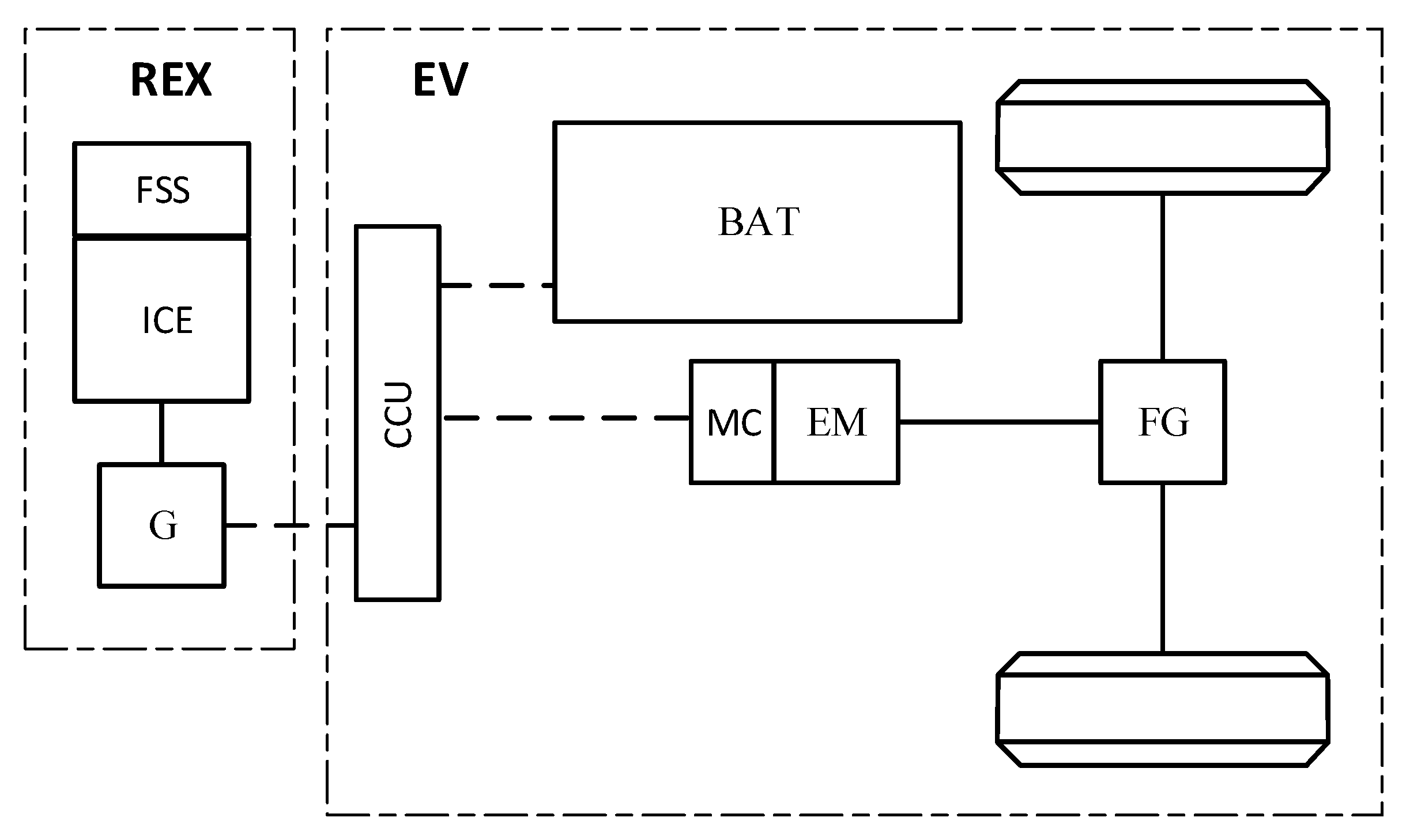
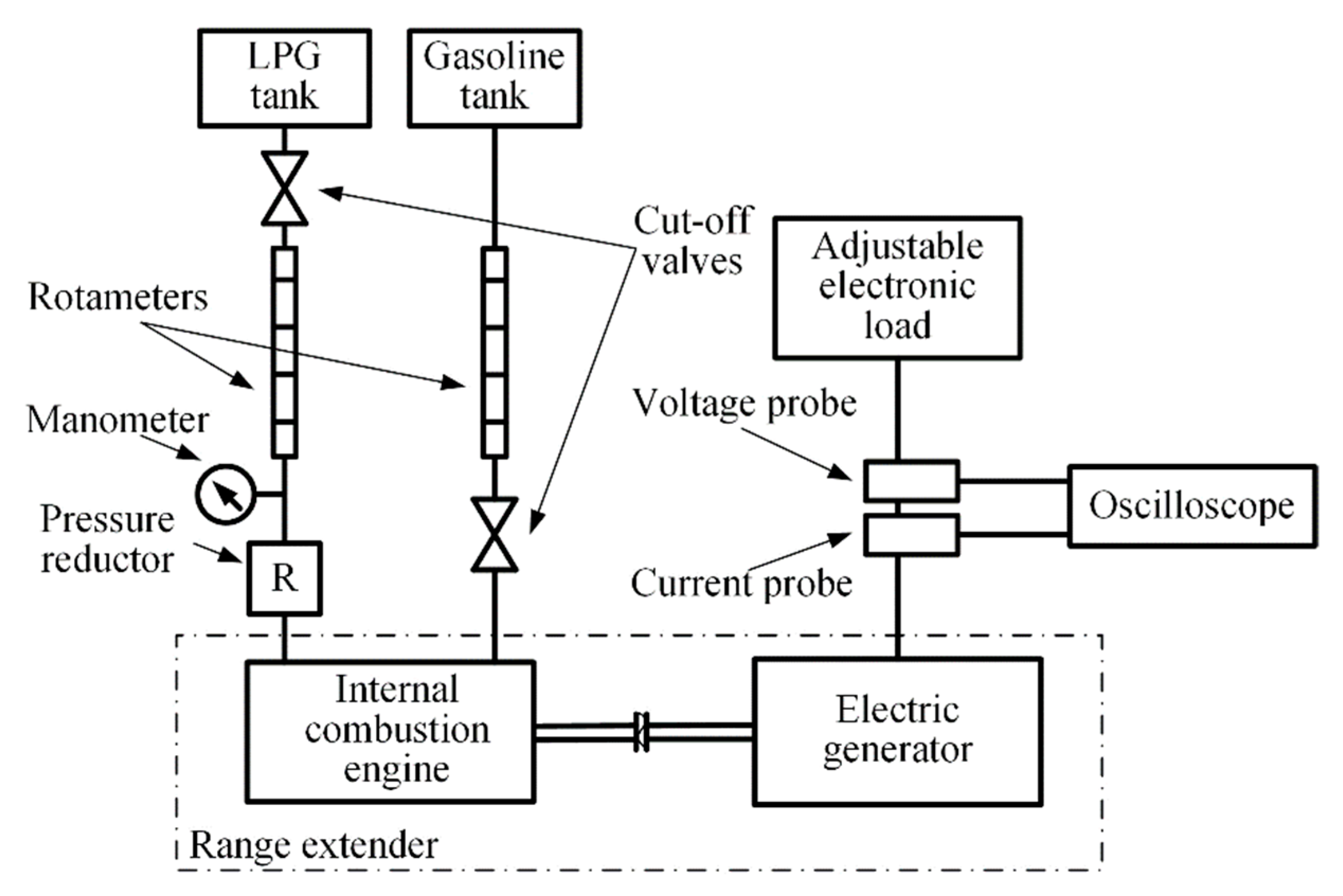
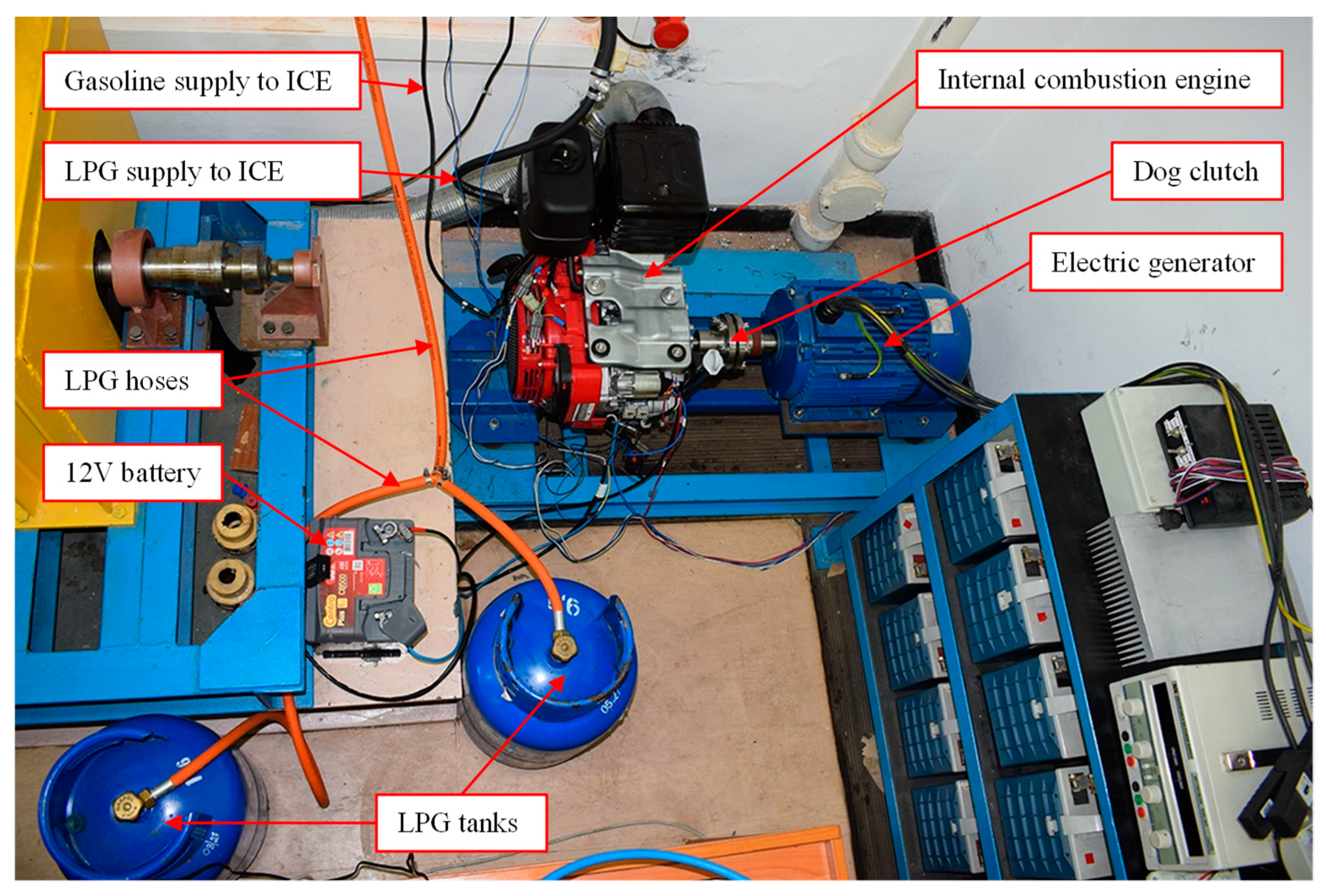
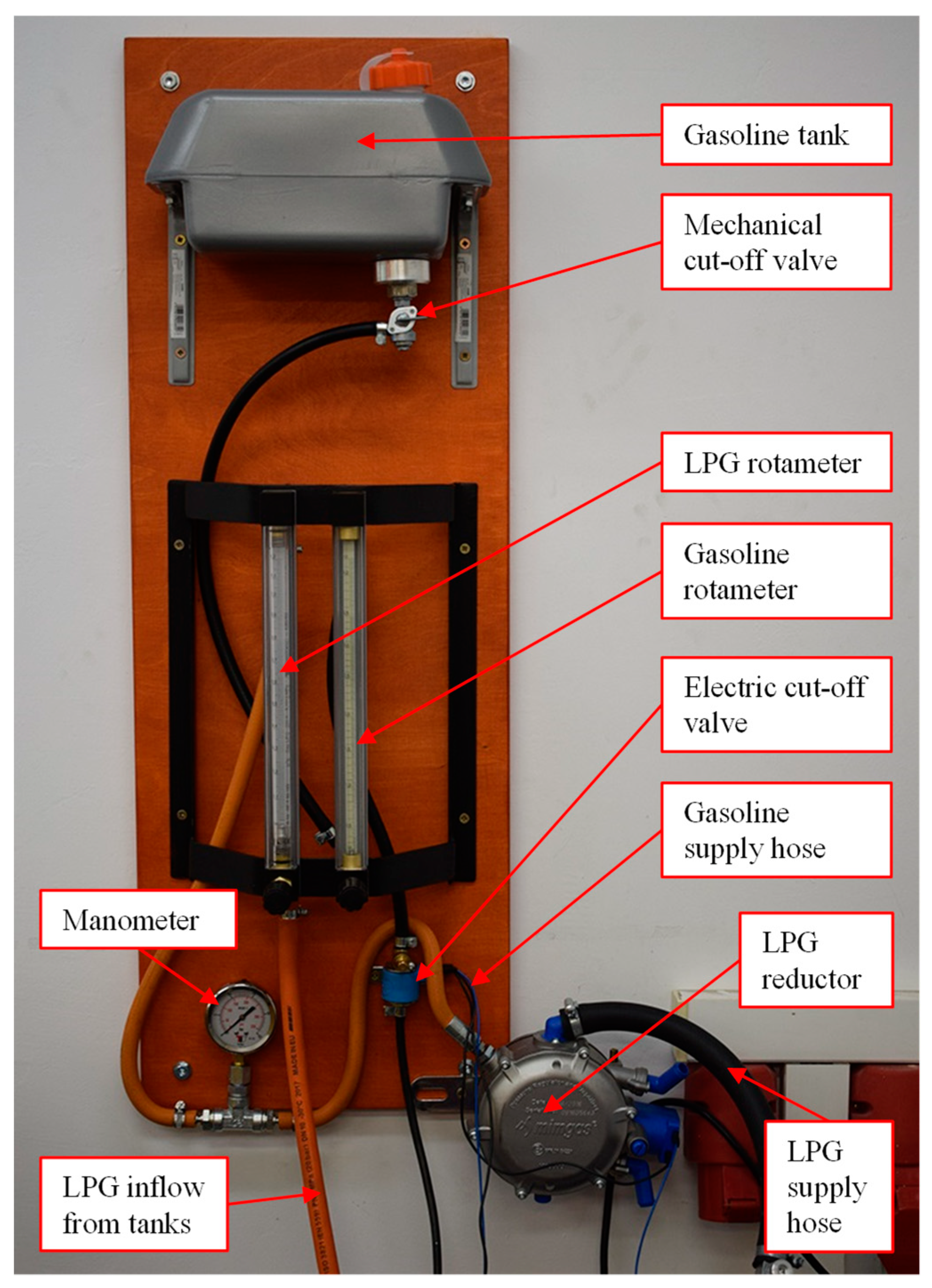
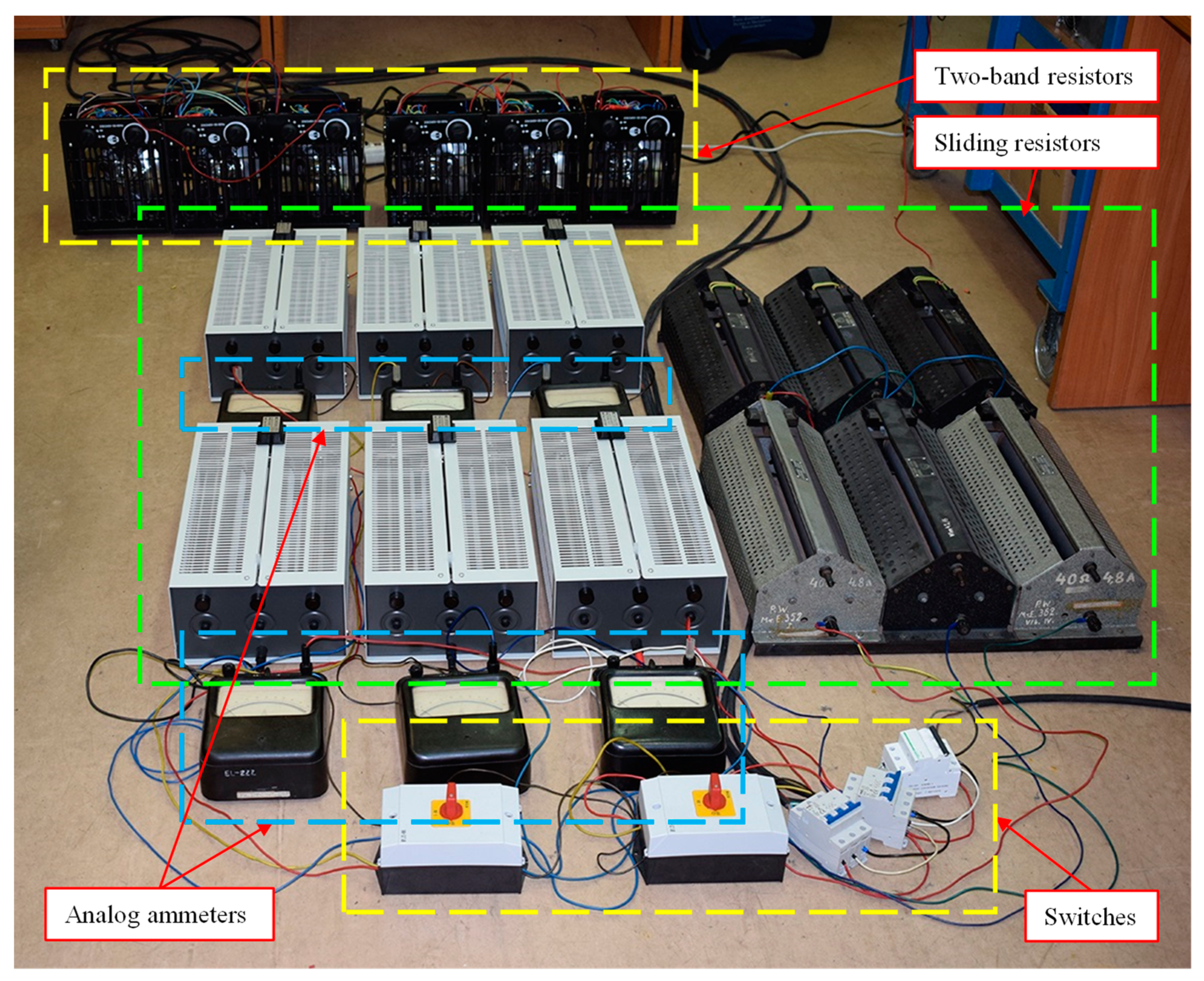
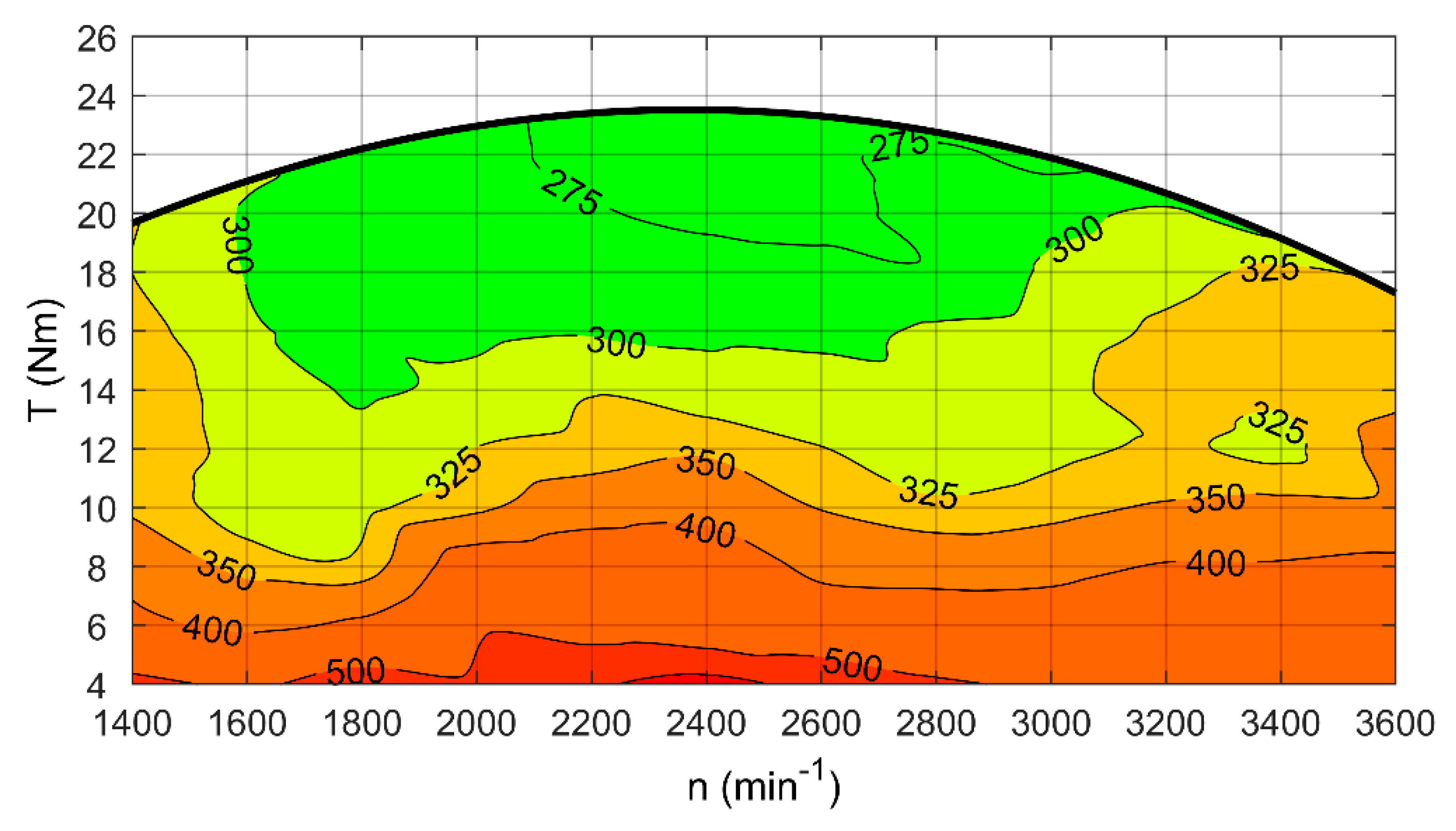
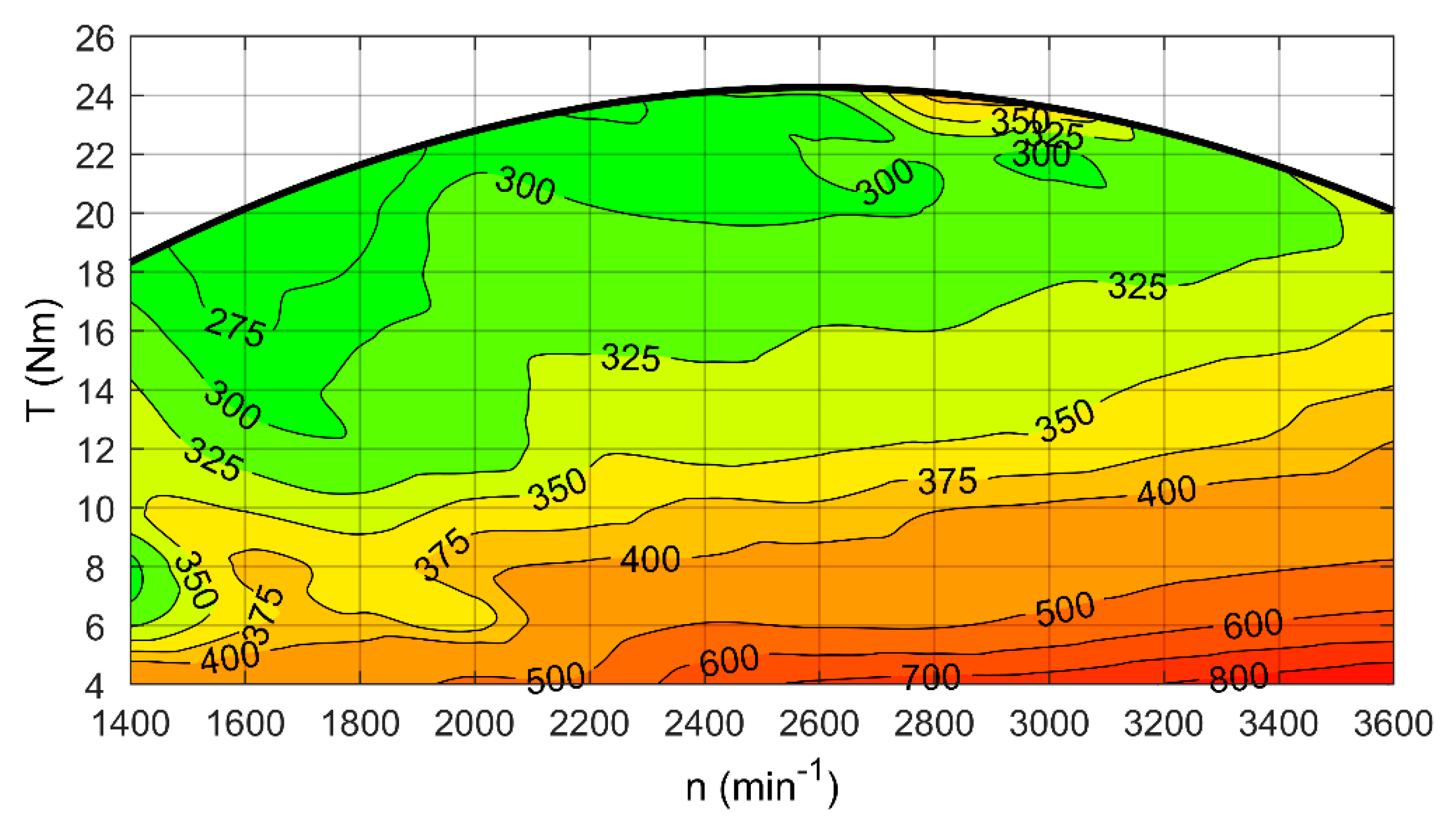

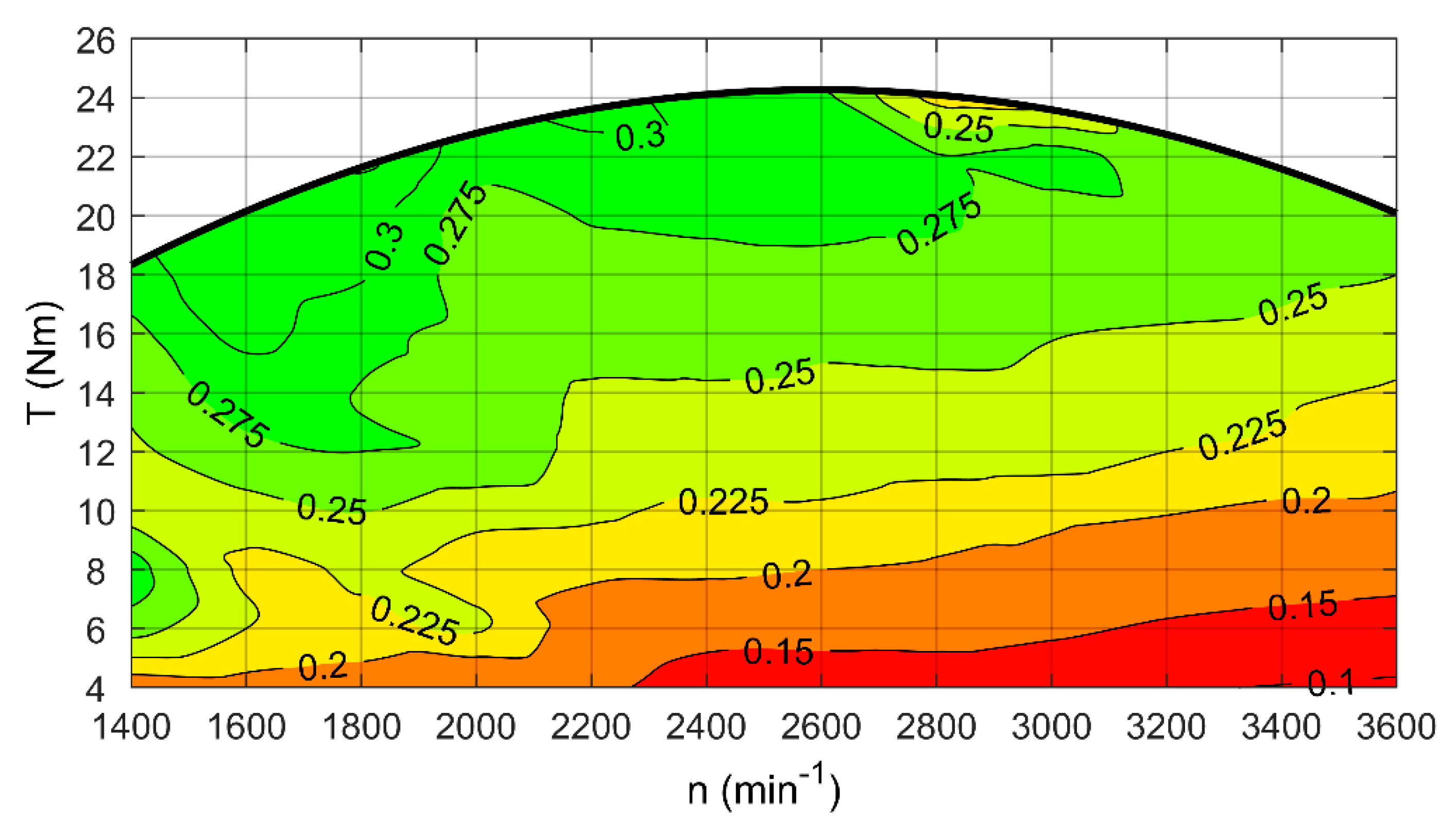
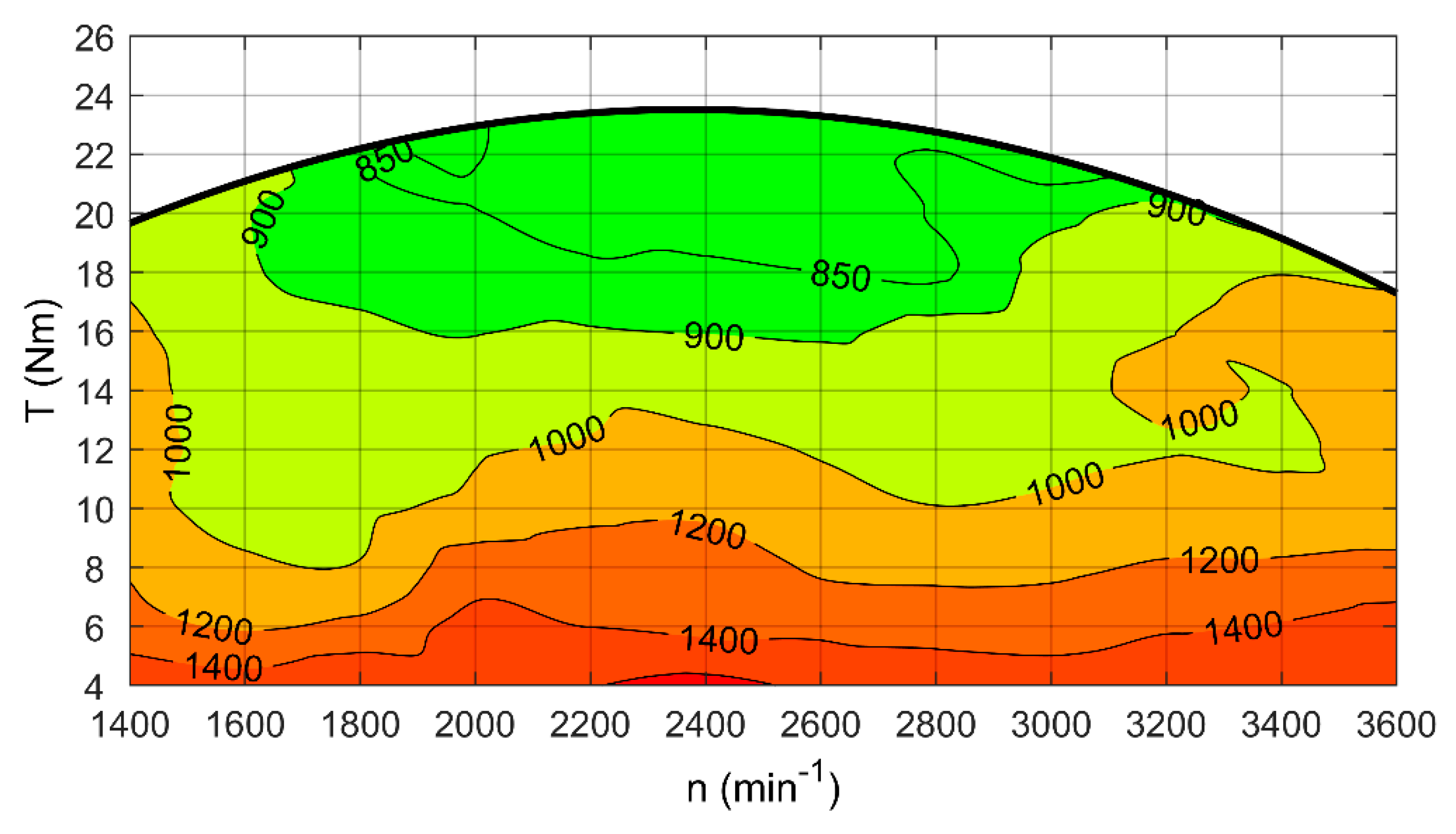
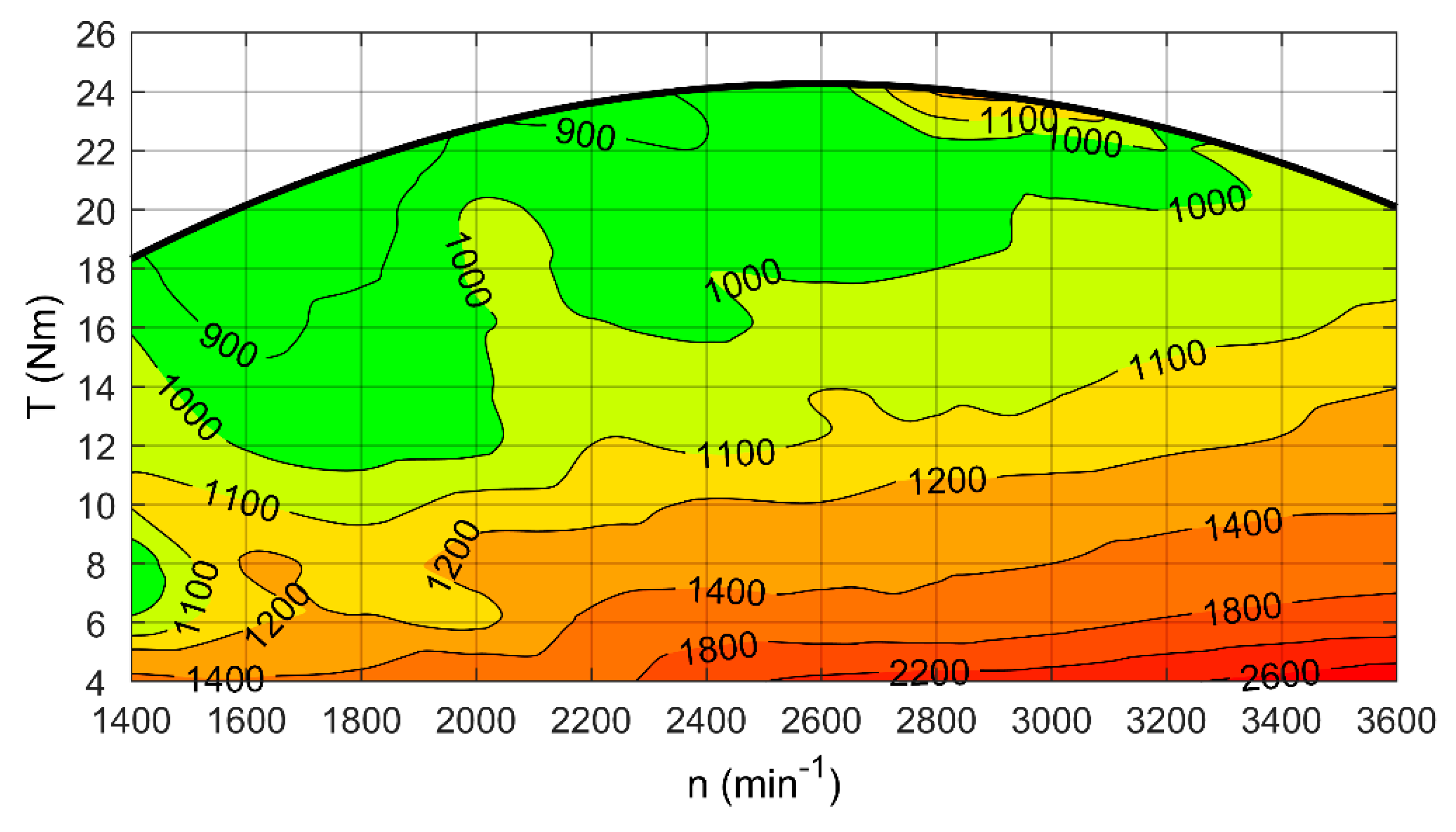


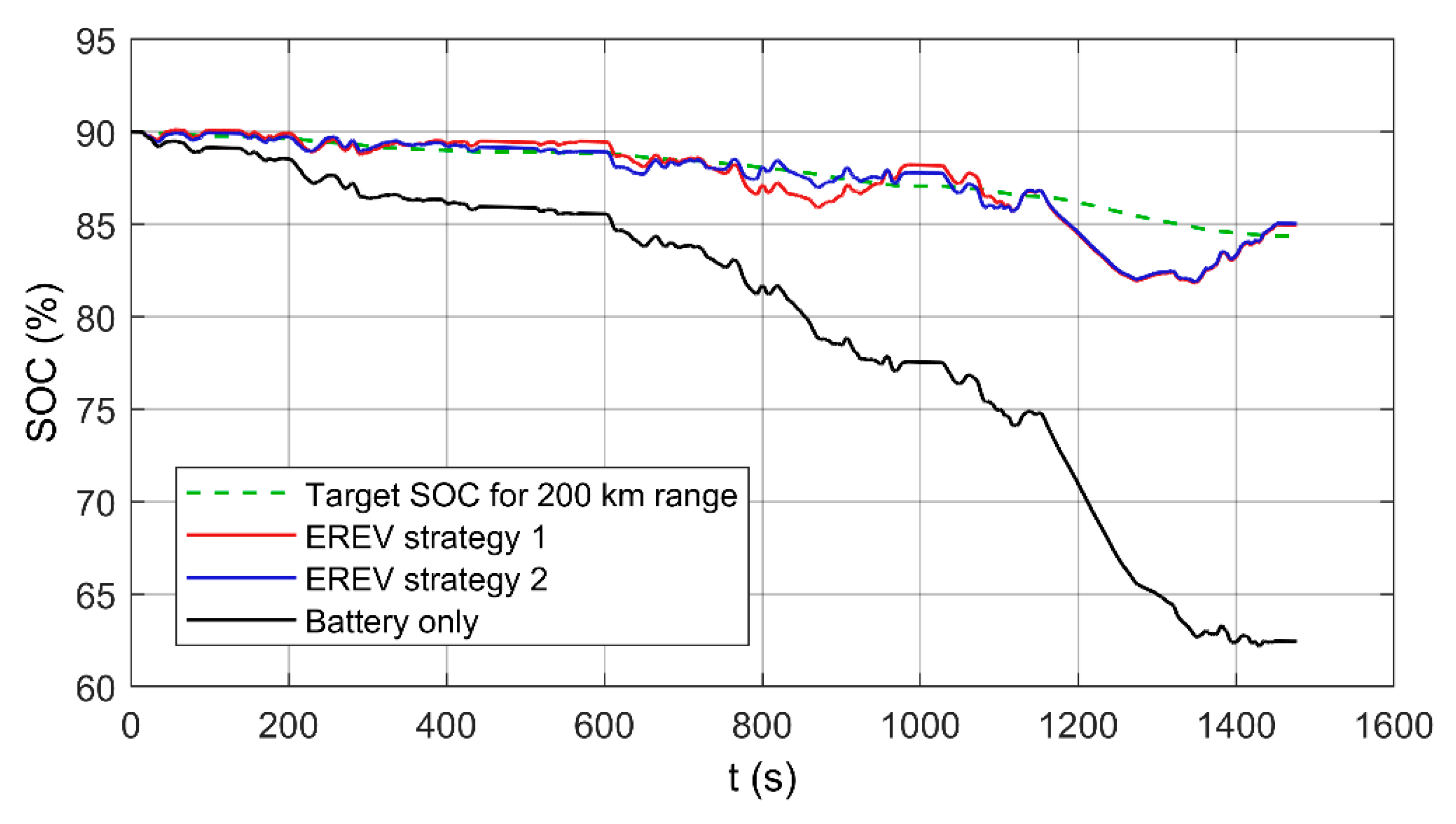
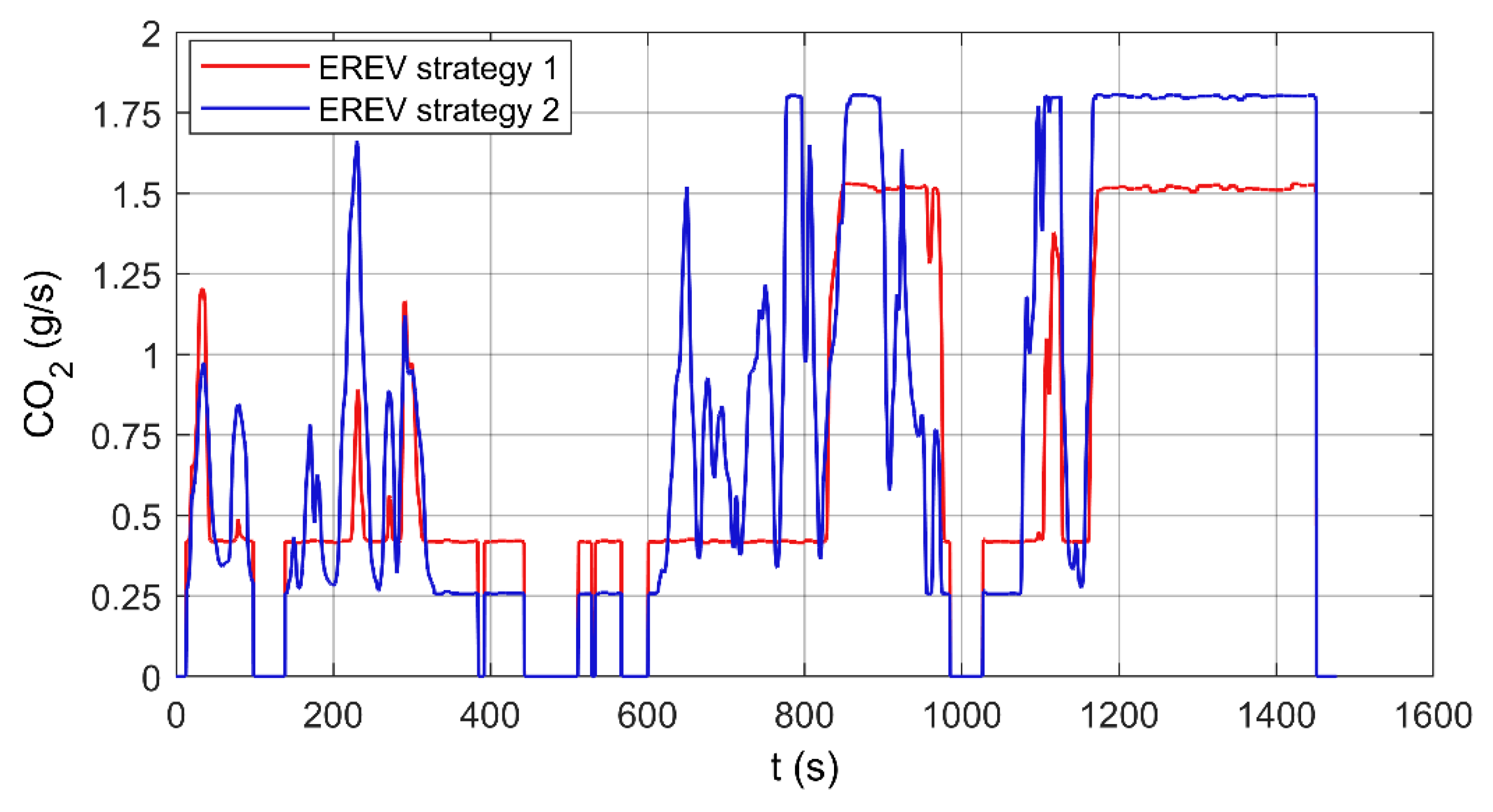

| Parameter | Data |
|---|---|
| Type | 4-stroke, OVH, single cylinder, inclined by 25° |
| Displacement | 438 cm3 |
| Cylinder bore/piston stroke | 88.0/72.1 mm |
| Compression ratio | 8.1 |
| Maximum effective power | 9.5 kW at 3600 min−1 |
| Maximum torque | 29.8 Nm at 2500 min−1 |
| Fuel supply system | Horizontal type butterfly valve carburetor |
| Ignition system | Digital Capacitor Discharge Ignition with variable ignition timing |
| Cooling system | Forced-air |
| Parameter | Data |
|---|---|
| Type | Permanent Magnet Synchronous Generator |
| Rated output power | 15.1 kW at 3600 min−1 |
| Rated torque | 41.3 Nm at 3600 min−1 |
| Rated efficiency | 97.2% |
| Parameter | Data |
|---|---|
| Flash-point temperature | under −10 °C |
| Autoignition temperature | 340 °C |
| Research octane number (RON) | Min. 95 |
| Motor octane number (MON) | Min. 85 |
| Density at 15 °C | 720–775 kg/m3 |
| Calorific value | Data not available |
| Vapor pressure at 37.8 °C | 60–90 kPa |
| Parameter | Data |
|---|---|
| Flash-point temperature | −95 °C (propane), −60 °C (butane) |
| Autoignition temperature | 365 °C (butane), 470 °C (propane) |
| Density at 15.6 °C (liquid state) | 549 kg/m3 |
| Calorific value | > 45.22 MJ/kg |
| Vapor pressure at 20.0 °C | 210.0 kPa (butane), 830.0 kPa (propane) |
| Parameter | Data |
|---|---|
| Mass | 1350 kg |
| Frontal drag coefficient | 0.29 |
| Frontal area | 2.47 m2 |
| Rolling resistance coefficient | 0.008 |
| Wheel moment of inertia | 0.56 kg∙m2 |
| Drivetrain combined gear ratio | 8.4 |
| Tire dynamic radius | 0.301 |
| Traction motor nominal power | 53.5 kW at 6500–8000 min−1 |
| Traction motor nominal torque | 78.6 Nm at 0–6500 min−1 |
| Maximal supply voltage | 320 V |
| Traction battery rated capacity | 58 Ah |
| Traction battery nominal voltage | 87.4 V |
| Parameter | ICE | Range extender (gasoline) | Range extender (LPG) |
|---|---|---|---|
| BSFC (g/kWh) | 283.26 | 334.32 | 288.13 |
| Thermal efficiency | 0.296 | 0.250 | 0.274 |
| CO2 emission (g/kWh) | 900.8 | 1063.1 | 873.0 |
| Parameter | Range extender | ||||||
|---|---|---|---|---|---|---|---|
| Laboratory | Commercial | ||||||
| Manufacturer | N/A | AVL | BMW | GM | MAHLE | Lotus | TATA |
| ICE configuration | 1-cyl. | R2 | R2 | R4 | R2 | R3 | R2 |
| ICE displacement (cm3) | 438 | 570 | 647 | 1490 | 900 | 1193 | 624 |
| ICE rated power (kW) at speed (min−1) | 9.5 | 18 | 25 | 75 | 30 | 38 | 27.6 |
| 3600 | 5000 | 4300 | 5600 | 4000 | 3500 | 5500 | |
| Electric power (kW) | 7.7/7.0 1 | 15 | 23.5 | 26 2 | N/D | 35 | ~25 |
| BSFC (g/kWh) | 334.3/288.1 1 | ~255 | 320 3 | ~230 | 240 | 241 | ~260 |
| Thermal efficiency | 0.250/0.274 1 | ~0.328 | 0.262 | ~0.364 | 0.349 | 0.347 | ~0.322 |
| CO2 emission (g/kWh) | 1063.1/873.0 1 | ~810.9 | 1017.6 | ~731.4 | 763.2 | 766.38 | ~826.8 |
| Reference | This study | [26] | [21] | [22,24] | [27] | [29] | [30] |
© 2019 by the authors. Licensee MDPI, Basel, Switzerland. This article is an open access article distributed under the terms and conditions of the Creative Commons Attribution (CC BY) license (http://creativecommons.org/licenses/by/4.0/).
Share and Cite
Lasocki, J.; Kopczyński, A.; Krawczyk, P.; Roszczyk, P. Empirical Study on the Efficiency of an LPG-Supplied Range Extender for Electric Vehicles. Energies 2019, 12, 3528. https://doi.org/10.3390/en12183528
Lasocki J, Kopczyński A, Krawczyk P, Roszczyk P. Empirical Study on the Efficiency of an LPG-Supplied Range Extender for Electric Vehicles. Energies. 2019; 12(18):3528. https://doi.org/10.3390/en12183528
Chicago/Turabian StyleLasocki, Jakub, Artur Kopczyński, Paweł Krawczyk, and Paweł Roszczyk. 2019. "Empirical Study on the Efficiency of an LPG-Supplied Range Extender for Electric Vehicles" Energies 12, no. 18: 3528. https://doi.org/10.3390/en12183528
APA StyleLasocki, J., Kopczyński, A., Krawczyk, P., & Roszczyk, P. (2019). Empirical Study on the Efficiency of an LPG-Supplied Range Extender for Electric Vehicles. Energies, 12(18), 3528. https://doi.org/10.3390/en12183528






